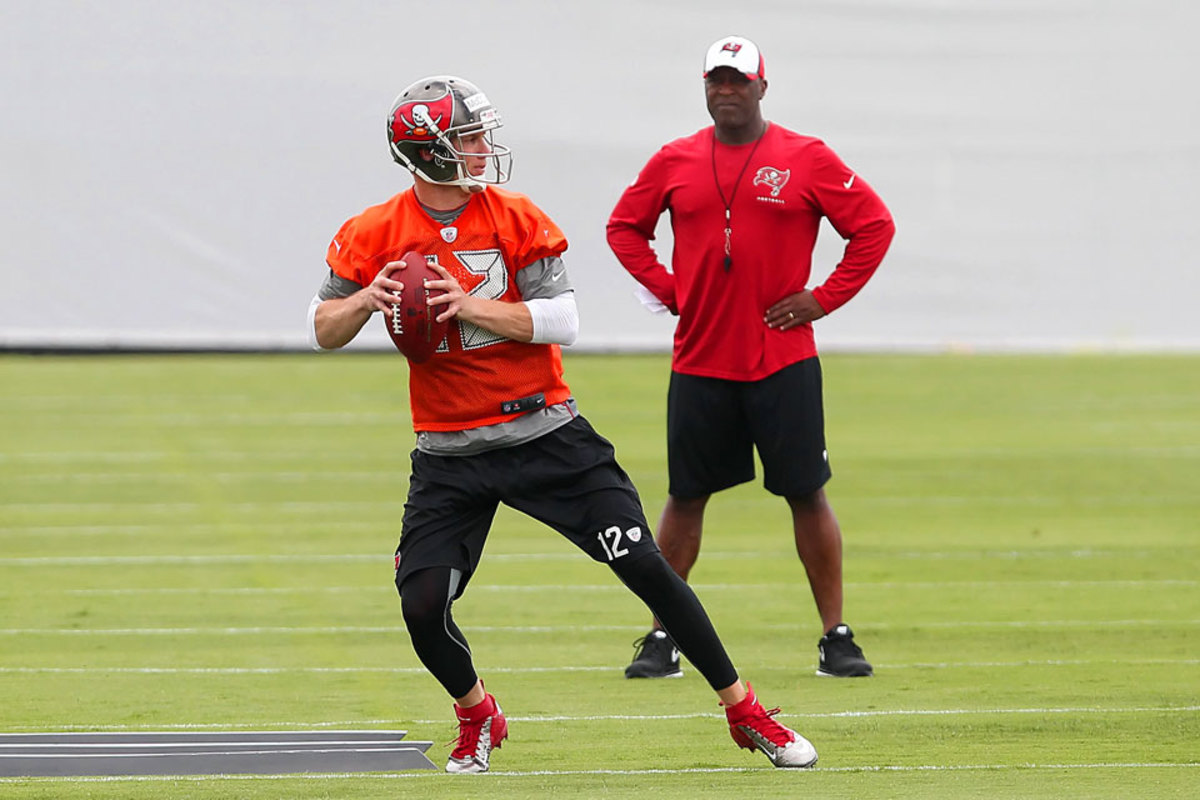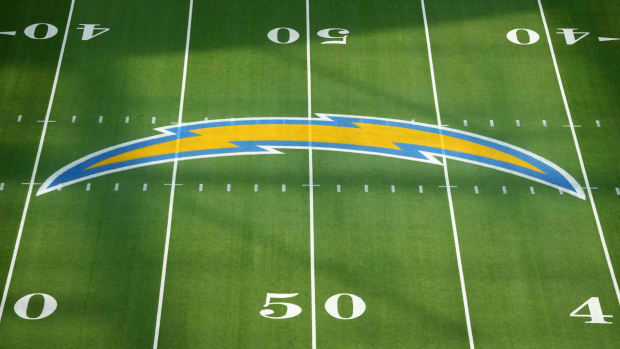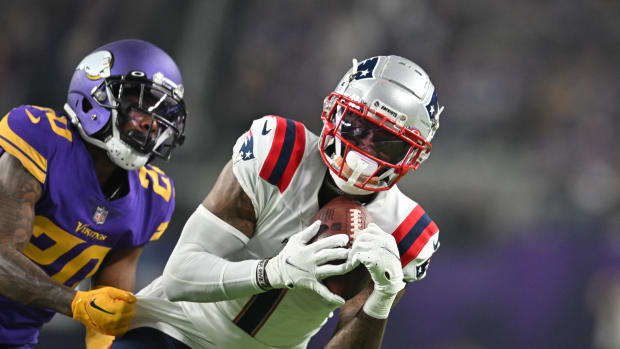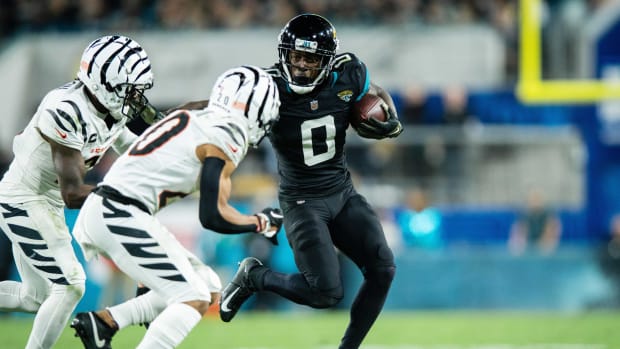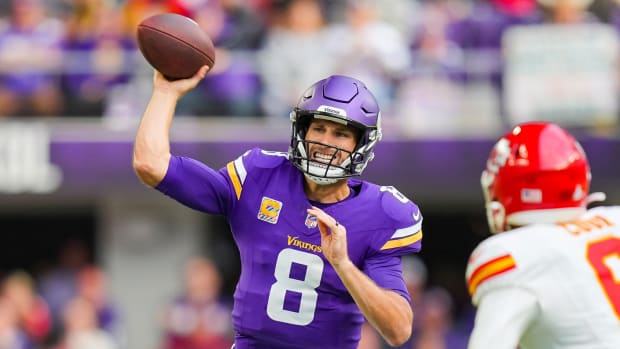Questioning the Practice
It’s the weekend, and if you’re here reading this on either Saturday or Sunday, you might be a hopeless shut-in who watches NFL Network in May (even after the draft) and swears this is the year for the Browns/Vikings/Jaguars/Raiders.
Or you might be my grandma.
Either way, we have stuff to talk about.
We’re still sifting through the consequences of the 2011 collective bargaining agreement. This past April, as has been the case over the past four years, NFL coaches began complaining about the CBA’s restrictions on offseason practices, which limits the amount of time teams can spend with players and what they can do during those periods.
The union’s idea in bargaining for the changes was to avoid offseason injuries and prolong careers. Ravens coach John Harbaugh’s recent counter was pretty simple: “They want to learn football. It’s their craft. And we’re saying, ‘No, you can’t do it?’ Why?”
In a conversation with The MMQB this week, new Bucs quarterback Josh McCown echoed those sentiments, pointing out the added pressure on players on teams with new head coaches, offensive coordinators and quarterbacks.
“It’s very frustrating. I understand completely the spirit of the rule and why it was fought for, and I don’t want to undermine what our union has done,” McCown says, “but at the same time, I scratch my head when we’re trying to learn a new offense and I have to tell my guys, hey we’re going to go over here to a public park to work on this, because we can’t do it at the facility.”
Where Legend Lives On
Virtually untouched since his passing in 2012, the domain Steve Sabol remains a shrine to the game that he loved—and that, through his epic mythmaking, he helped turn into an American institution with NFL Films. FULL STORY
After talking to Josh, I was ready to go on the warpath. The NFLPA, I thought had damaged the competitive balance of the league by limiting practice time. Then I looked up the stats.
In the two seasons before the lockout, back when coaches held players hostage at the facility with “voluntary” workouts during the springs and summers of 2009 and 2010, 11 teams entered new seasons with a new HC/OC/QB.
Their subsequent performances, averaged:
Avg. offensive points per game rank: 24
Avg. yards per game rank: 24.5
Avg. starting QB rating: 70.9
Gross September record: 15-25
Now, take the two most recent seasons since the new CBA (2012 and 2013) in which seven teams had a new HC/OC/QB:
Avg. offensive points per game rank: 21.1
Avg. yards per game rank: 19.7
Avg. starting QB rating: 79.4
Gross September record: 13-15
What happened? The same thing that makes McCown scratch his head appears to have improved the chances of new football regimes finding more success. Players took ownership, staging practices in public parks and at local high schools, and the net effect was largely positive.
Just to make sure, I asked around the league about how many quarterbacks were holding offsite workouts before 2011. The response, summed up by former Chiefs coach Herm Edwards, “Very few.”
So the CBA seems to have improved parity by limiting the time that coaches can spend with players in the offseason. That history bodes well for the Browns, Texans, Vikings and Bucs, who are each likely to start someone new at QB after switching coaches in 2014. But it’s little consolation for McCown, who’d rather just keep working at One Buc Place, whether coaches are present or not.
“It’s not the worst thing in the world, but it’s like telling the people at the Ford company, ‘Hey man, you’ve got to go offsite to put the brake pads on,’ ” he says. “You wish there was some way we could come together and say this is what the players are allowed to do and we would not have to seek other places to work.”
It’s something to ponder as the union and league owners consider amendments to the CBA in the coming years.
#ChuckStrong Is a Brotherhood
John Biever for Sports Illustrated/The MMQB
Dressed in dark blue jeans and a slick white dress shirt, Colts coach Chuck Pagano looked to be the picture of health on May 3, sporting a big smile as he spoke to the crowd at the second annual ChuckStrong Tailgate Gala to raise money for cancer research. Nearing the two-year mark in his recovery from Acute Promyelocytic Leukemia, Pagano remains in complete molecular remission and says he doesn’t worry about the cancer coming back.
“No. Not at all. Until people ask me, I never even talk about it,” he says. “Every now and then, me and my wife get reminded of certain things and think back to the time spent in the hospital. But the way I feel now, it’s almost like, did it really happen? It almost seems surreal to be honest with you.”
Entering his third season in Indianapolis, Pagano admits that there is now a greater sense of normalcy going into the fall. “Even coming back at the end of the first year, coming back for that second season—it was really like my rookie season,” he says.
Along with checkups every three months, Pagano takes a drug called ATRA in two-week cycles four times a year. Come August, Pagano’s checkups will be spaced out every six months for the next three years. By then, Pagano will have reached the five-year mark of remission—the magic number for a full recovery from leukemia.
Pagano’s vision for the Colts is simple and straightforward. “It’s right up there on that wall,” he said, pointing to a huge banner of the Lombardi Trophy hanging in the team’s practice facility. “It’s chasing that Lombardi. I know beyond a shadow of a doubt we’re going to hoist that thing. Our vision and goal for curing cancer is no different. That’s why we’re here tonight as a group and a family—so that someday we can say, ‘Hey, we hoisted the Lombardi. We found a cure for all kinds of cancer.”
Several Colts players, including Andrew Luck, were on hand for the Gala, which raised $632,000 for research at the IU Simon Cancer Center. The center’s director, Dr. Patrick Loehrer, spoke of the ChuckStrong Gala as something much greater than raising money. “It really is about brotherhood,” he said. “Coach developed cancer, and his first thought was to help people. That really is contagious.”
NICKEL PACKAGE
1) It’s hard to look at Panthers defensive end Greg Hardy’s “Kraken character” the same way after he allegedly assaulted a woman in home last Tuesday. According to court documents, “The victim stated she was lying in bed with the defendant and he just snapped,” which is exactly how Hardy has described the sudden emergence of his Kraken alter ego during football games. Hardy is accused of tossing Nicole Holder, 24, on a “couch covered in assault rifles and/or shotguns” and threatening to kill her. The incident allegedly stems from Holder’s short-lived relationship with the rapper Nelly after she and Hardy had broken up. “Once you piss me off,” Hardy told me during Super Bowl week, “I forget everything. Everything after that is the monster.” Scary stuff, considering the assault charge.
Panthers defensive end Greg Hardy leaving the Mecklenburg County jail in Charlotte, N.C., on May 14 (l.), and the "Kraken" before a playoff game against the 49ers in January. (AP :: Kevin C. Cox/Getty Images)
2) Getting Johnny Manziel at No. 22 wasn’t close to Cleveland’s best value pick in the 2014 draft. That distinction belongs to their second-round choice, Joel Bitonio out of Nevada. The college tackle will likely shift down to guard and challenge Jason Pinkston or John Greco for a very critical starting job. In signing running back Ben Tate and drafting Towson’s Terrance West, the Browns have demonstrated they intend to take pressure off Manziel with the running game, and both Pinkston and Greco share some blame for the fifth-worst rushing attack in football last season.
3) I bet it will be a while before we see Mike Glennon, Lovie Smith’s “quarterback of the future,” under center in Tampa. McCown, a journeyman who rededicated himself to the game during a season out of football, is being compared to Rich Gannon after a 13-touchdown, one-interception stint last season in Chicago when he filled in for an injured Jay Cutler. Gannon led the Raiders to the Super Bowl in 2002, McCown’s rookie year. “I loved the story, him doing it later in his career, it was really neat,” McCown says. “It’s not even fair to compare me to him. When he would drop back he knew exactly where he was going with the football. There was an intelligence to the way he played that stuck with me as a young player.”
10 NFL Insights
Andrew Brandt on Jerry Jones showing restraint, Tom Brady’s contract future, Chip Kelly’s honesty, the Dolphins’ double-standard and much more. FULL STORY
4) You could make the argument the draft needed to be moved up in April, rather than back to May.
I did last week. Here’s another point I want to emphasize: Those extra weeks of downtime help set in motion the mismanagement of money that’s rampant among NFL players. Shady marketing men and friends with investment opportunities come out of the woodwork after players declare for the draft, yet the selection doesn’t happen until May, and the rookie symposium—which helps educate players about life in the NFL—doesn’t happen until late June. “Once people know that kids coming out of college are about to have a ton of cash,” says Bengals second-year running back Gio Bernard, “that draws them. It’s not like we see that kind of money every day or have ever seen it.” So why not limit exposure to these outside influences and move up the draft and the rookie symposium?
5) It was interesting to see Stanley Jean-Baptiste, a 6-foot-3 corner out of Nebraska, picked with the 58th choice in the second round by the Saints. One scout I spoke with before the draft pegged him as a fourth-rounder, and a defensive coordinator suggested a player of his caliber wouldn’t have been taken until the sixth or seventh round a decade ago. But Jean-Baptiste’s size and ball skills translate nicely to the Seahawks’ model of cornerback play, which was given the ultimate stamp of legitimacy with a Super Bowl thrashing of the Broncos. As teams stock up on big corners in coming years, I expect to see offenses respond by isolating smaller slot receivers on the outsides in search of a quickness mismatch. The offense, it seems, always wins these chess games eventually.
































